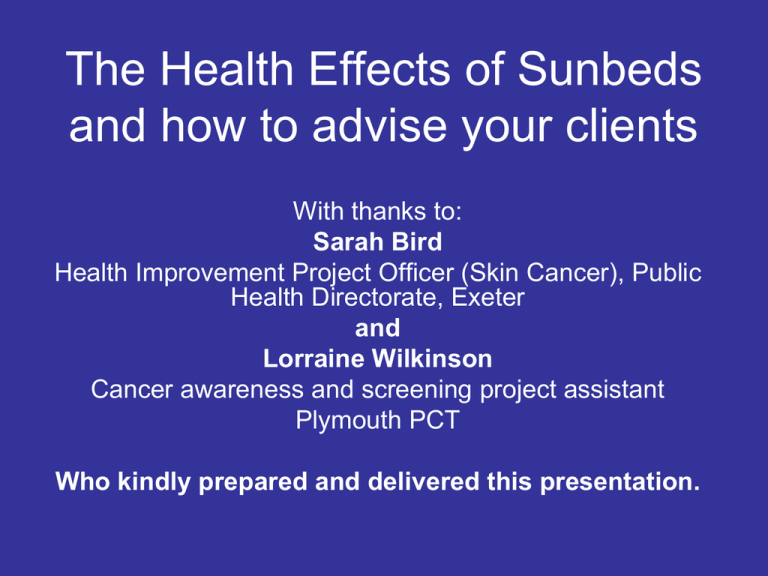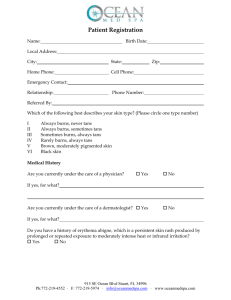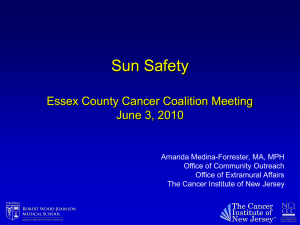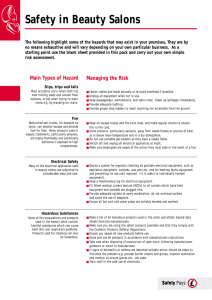Health effects of using sunbeds
advertisement

The Health Effects of Sunbeds and how to advise your clients With thanks to: Sarah Bird Health Improvement Project Officer (Skin Cancer), Public Health Directorate, Exeter and Lorraine Wilkinson Cancer awareness and screening project assistant Plymouth PCT Who kindly prepared and delivered this presentation. Skin cancer – what’s the issue? Test your knowledge… Plymouth has the… a) Highest rate of malignant melanoma in the country? b) The 4th highest rate of malignant melanoma in the country? c) The 20th highest rate of malignant melanoma in the country? Skin cancer is most common in… a) Teenagers? b) People aged 20-50? c) People over 50? For 15-34 year olds, skin cancer is the… a) Rarest cancer? b) 2nd most common cancer? c) Tenth most common cancer? Which statement is true? a) Skin cancer is not preventable b) 50% of skin cancers are preventable c) 80% of skin cancers are preventable Avoid burning Getting a painful sunburn just once every two years can triple the risk of malignant melanoma Know your skin People with fair skin that burns easily, lots of freckles, moles, a history of sunburn and family/personal history of skin cancer are more at risk and need to take extra care Seek shade In the UK, the sun is strongest between 11am and 3pm. Abroad, the sun is strongest when your shadow is shorter than your height – seek shade during this time. Cover up Protect your skin with clothing such as sunglasses, hat and t-shirt Hat may be stylish… …or not so stylish, as long as it does the job. Sunglasses Sunscreen – know how to use it • Use at least SPF15 • Use a ‘broad-spectrum’ (UVA and UVB protection) sunscreen with a 4* rating • Reapply regularly and generously • Most sunscreens expire after 1-2 years so make sure yours is in date • Cheaper sunscreens can be just as effective as the expensive ones • Don’t rely on sunscreen as your only form of protection • No sunscreen gives 100% protection so don’t be tempted to stay out longer Avoid binge-tanning Government advice is to avoid using sunbeds Based on World Health Organization (WHO) and Department of Health advice, you should not use UV tanning equipment if you: • have fair, sensitive skin that burns easily or tans slowly or poorly; • have a history of sunburn, particularly in childhood; • have a large number of freckles and/or red hair; • have a large number of moles; • are taking medicines or using creams that sensitise the skin to sunlight; • have a medical condition that is worsened by sunlight; • or anyone in your family has had skin cancer in the past; • already have extensive skin damage due to sunlight. • The Sunbeds (Regulation) Act, effective from April 2011, makes it illegal to let under 18s use UV tanning equipment in salons Skin type • Type I - Often burns, rarely tans. Tends to have freckles, red or fair hair, and blue or green eyes. • Type II - Usually burns, sometimes tans. Tends to have light hair, and blue or brown eyes. • Type III - Sometimes burns, usually tans. Tends to have brown hair and eyes. • Type IV - Rarely burns, often tans. Tends to have dark brown eyes and hair. • Type V - Naturally black-brown skin. Often has dark brown eyes and hair. • Type VI - Naturally black-brown skin. Usually has black-brown eyes and hair. • Sunbeds are estimated to cause around 100 deaths from melanoma every year in the UK • Using sunbeds for the first time before the age of 35 increases the risk of developing melanoma by 75% • Sunbeds may be mostly UVA, but UVA has now been proven to contribute to skin cancer as well as UVB • WHO has now classified sunbeds as ‘definitely carcinogenic’ – same category as tobacco and asbestos • At most, a sunbed tan is the equivalent of sunscreen with an SPF of 2-4 – not enough to protect you • You don’t need to use a sunbed to get enough vitamin D Spotting skin cancer early • Asymmetry The two halves of your mole do not look the same. • Border The edges of your mole are irregular, blurred or jagged. • Colour The colour of your mole is uneven, with more than one shade. • Diameter Your mole is wider than 6mm in diameter (the size of a pencil eraser). Other signs of skin cancer • a new growth or sore that won't heal • a spot, mole or sore that itches or hurts • a mole or growth that bleeds, crusts or scabs White patches = healthy skin, less exposed, e.g. eyelids, under eyebrows, under nose Purple patches = where skin is thinner/dehydrated Freckles/pigmentation = sign of skin type but also of sun exposure White specks = dust/dead skin cells Fluorescent pores = oily Nose is often more damaged Gemma Merna (Hollyoaks)











